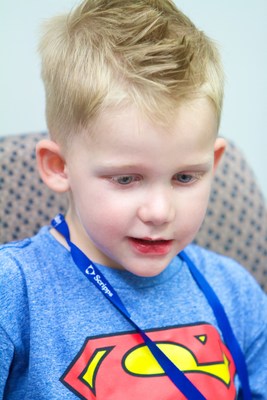Scripps Health Release: 5-Year-Old Brain Cancer Patient Completes Proton Therapy, Awaits Kindergarten
SAN DIEGO, Sept. 23, 2014 /PRNewswire/ -- While proton therapy recently began in the Czech Republic for British pediatric brain cancer patent Ashya King, another case in the United States draws to a close today with a promising outlook, as a young boy who was given just days to live now looks forward to his first day of kindergarten.

When 5-year-old Logan Green of Arizona complained of a headache in June, it was the first step in a dizzying journey of medical treatments that will conclude Sept. 23, when he completes proton radiation therapy for a brain tumor.
Minutes after his headache began, Logan collapsed and was air-lifted to a hospital emergency room in Arizona. Logan's parents said doctors gave them a grim diagnosis. Logan had an aggressive and inoperable brain tumor and likely had only three days to live. They said doctors advised against further medical treatment.
But a second medical opinion led to successful surgery to remove most of the tumor. Logan spent the next 30 days in the intensive care unit, followed by two weeks in rehabilitation, where he re-learned how to walk and talk. Microscopic remnants of the tumor were likely lingering in his brain after surgery, so Logan required radiation therapy to kill any remaining cells to keep the disease from returning.
"After learning about the serious side effects that standard X-ray radiation treatment can have on children, we did our homework and learned that proton radiation therapy is an alternative that can help minimize possible long-term damage," said Logan's mother, Crisandra Green.
Along with his parents and four siblings, Logan traveled from the Phoenix area to San Diego for his treatments at Rady Children's Hospital at Scripps Proton Therapy Center. Every weekday since early August, he has been treated with a highly accurate beam of protons to target a tumor that was the size of a ping pong ball situated in the back of his brain.
Logan's treating physician, Andrew L. Chang, M.D., said the tumor was located in a highly sensitive area between the brain stem and cerebellum. "This is a region of the brain that is involved in movements and feelings and controls vital functions such as breathing and the heartbeat, so accuracy of treatment is critically important," said Dr. Chang, who practices at Scripps and Rady Children's.
A conventional X-ray treatment beam would have continued past Logan's tumor and irradiated healthy portions of his brain, face and throat, increasing his probability of side effects such as cognitive and memory problems, as well as secondary cancers caused by the radiation. By comparison, doctors can control a proton radiation beam to stop where the tumor stops, protecting nearby critical organs.
The Scripps Proton Therapy Center uses pencil-beam scanning, the latest advancement in proton therapy. Pencil-beam scanning sweeps a narrow proton beam across the tumor in fine strokes, building up the dose layer by layer. The result is a dose of cancer-killing radiation that conforms precisely to the unique shape of the tumor.
Dr. Chang said Logan's proton treatments have been delivered successfully, though it will take several years to ensure the tumor does not return. Logan and his family plan to return to Arizona, where Logan's kindergarten teacher has saved his seat in class, awaiting his arrival to school in October.
Recent research has shown that for pediatric brain cancer patients, proton therapy reduces the risk of second cancers, and also helps preserve cognitive function, compared to conventional X-ray radiation.
John Crawford, M.D., heads Rady Children's neuro-oncology department and is part of the tumor board that reviews pediatric patients who are considered for proton therapy. "We are very proud of the multidisciplinary tumor board we have in place to ensure all children receive the highest standard of care. Proton beam technology is an important tool in the fight against brain cancer and we are fortunate to have this available in our own backyard."
A non-invasive treatment, proton therapy is also considered highly effective for adults who have solid, deep-seated tumors that have not spread to distant parts of the body. Proton therapy has been used in the United States since the 1950s but is only recently becoming more available. The Scripps Proton Therapy Center in San Diego opened earlier this year for patient care. It is the 15th proton center in the United States.
Advanced Particle Therapy is the developer and owner of the Scripps Proton Therapy Center. Scripps Health provides the center's clinical management services and Scripps Clinic oversees the medical services. Varian Medical Systems of Palo Alto, Calif., developed and installed the center's ProBeam® proton delivery system.
For more information, call 858-549-7400.

Photo - http://photos.prnewswire.com/prnh/20140922/147644
Logo - http://photos.prnewswire.com/prnh/20121018/LA95241LOGO
SOURCE Scripps Health
